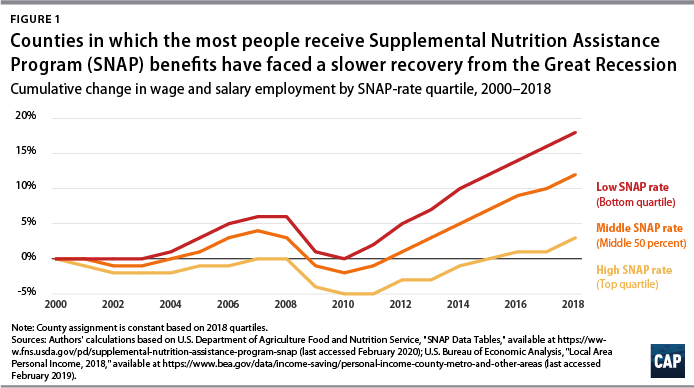There are dozens of programs on the chopping block in the Trump administration’s fiscal year 2021 budget proposal. Yet the administration’s most blatant attempt to gut the programs on which American families depend comes in the form of additional cuts to the Supplemental Nutrition Assistance Program (SNAP), the nation’s largest nutrition assistance program. The proposed budget contains a devastating $182 billion cut to SNAP over the next decade, a reduction of approximately 28 percent compared with the baseline level estimated by the Congressional Budget Office.
SNAP is a vital support that was used by 34 million Americans in an average month in 2019, and the entire program still costs less than President Donald Trump’s tax cuts for the richest 1 percent of American households. Targeting SNAP for cuts therefore makes a negligible difference for the overall budget but does considerable harm to families. These cuts clearly demonstrate who the Trump administration prioritizes.
New research shows that despite low unemployment and other surface-level indicators of a strong economy, nearly 51 million American households—43 percent of all households—are unable to afford basic necessities such as food, transportation, and health care. There are 16.1 million American households officially in poverty, in addition to 34.7 million households who aren’t officially under the poverty line but whose low-paying jobs and high rents and health care costs mean that they must often go without basic necessities.
In a recent poll of registered voters conducted by the Center for American Progress, a staggering one-third of respondents said that, at some point over the past year, they or an immediate family member had too little money to buy food. Food insecurity is particularly prevalent for older adults; Black, Latinx, and American Indian families; and people in rural areas. For families like these, SNAP is a necessary—although often insufficient—protection against hunger.


As shown in the figures above, counties where residents use SNAP the most tend to have had the slowest economic growth and most tenuous labor market conditions. These counties took much longer to recover from the Great Recession and continue to face unemployment rates that are higher than those of the rest of the nation. At the height of the recession, these counties had an unemployment rate of nearly 12 percent, which has had long-ranging consequences for the areas’ economic stability—even a decade later.
While the Trump administration often touts a booming economy, low overall unemployment belies the differences between local conditions across the country. For example, cities such as McAllen, Texas, and Fresno, California, have unemployment rates that are twice as high as the national rate. Historically, states have been able to relax some paperwork requirements for SNAP recipients to prove that they are working in areas with high unemployment rates. However, in December 2019, the Trump administration limited states’ ability to account for local availability of jobs by changing the rule governing the long-standing waiver system. It is now more difficult for struggling areas to give residents longer to find a job when jobs are scarce; in the event of a future economic downturn, this rule change will make it harder for everyone to recover.
Policies that require people to prove that they’re working before they can receive benefits rely on debunked stereotypes about fraud and human behavior. Behavioral economic and psychological research has repeatedly shown that scarcity makes it harder for people to plan for anything other than the most immediate emergency. Children who don’t have enough food have worse health and learning outcomes. Adults’ decision-making is influenced by even the perception or fear of scarcity. Moreover, job-seekers are more successful in their searches when they have reliable access to food, shelter, and other basic necessities. Taking SNAP away from families when they lose a job simply punishes those who are already struggling to make ends meet, pushing them deeper into poverty and disrupting their efforts toward financial security.
President Trump’s proposed cuts to SNAP should come as no surprise. His administration has demonstrated an unwavering commitment to restricting families’ access to food. Last year’s budget proposed cuts to SNAP, and the administration spent the next year finding new ways to make those cuts a reality. Each year’s budget under this administration has compounded the cuts of past years, placing the burden on families struggling to make ends meet.
Lily Roberts is the director of Economic Mobility at the Center for American Progress. Galen Hendricks is a research assistant for Economic Policy at the Center.